As streaming services, personalized playlists, and on-demand access have become the norm, they have created a vast range of opportunities within the digital space. As a result, the desire to create a music streaming app has become an enticing prospect.
This article walks you through the whole process, from conducting your first market research to launching your app and keeping it fresh after it goes live.
At Miquido, we’ve built our experience in the music and streaming app development for over 12 years, working on exciting projects like Onkyo Music, a conference app for Warner Recorded Music, the Topline app for Abbey Road Studios, and Klassik Radio for a German broadcaster. We’ve learned a lot from these experiences, and we’re ready to share some practical advice on how to develop a music streaming app.
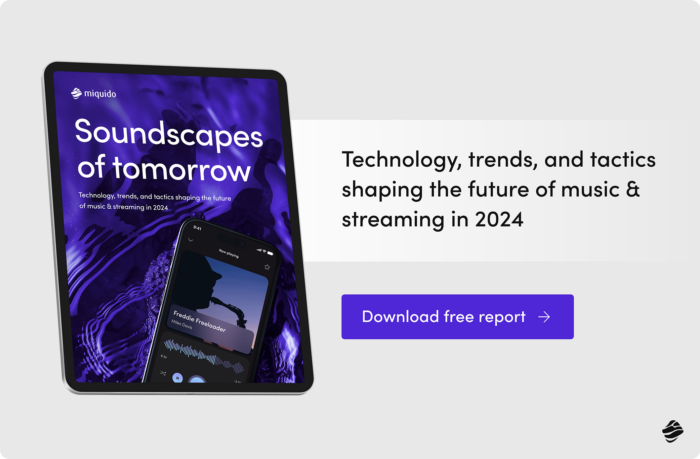
Let’s find out how you can turn your app idea into an instant hit!
Opportunities, challenges, and facilitators
Venturing into the music streaming app development space presents both promising opportunities and potential risks. Entrepreneurs can tap into the expanding global music-streaming market, explore diverse business models, and leverage cutting-edge technologies. This landscape offers the possibility to build innovative apps, such as successful music streaming apps like Spotify or Apple Music, with features like high-quality audio streaming and offline access.
On the other hand, developers must navigate significant challenges, including intense competition in the music industry, the need to quickly respond to shifting user preferences, and overcoming technical barriers. Success in this field requires careful planning, especially around areas such as music licensing and integration with record labels.
Understanding the music streaming app market
The music streaming app market has experienced significant growth in recent years, with the global online music streaming market valued at $13 billion in 2019 and estimated to reach $24 billion by 2027. This rapid expansion is driven by the increasing demand for on-demand music access and the convenience of streaming services.
Key players dominate the market, with Spotify holding the highest market share at almost a third (31%). Apple Music follows with a 15% market share and 88 million subscribers, while Amazon Music holds a 13% share with over 68 million subscriptions. These giants set the benchmark for features and user experience, making it essential for new entrants to offer unique value propositions to stand out.
To understand the music streaming app market, it’s crucial to analyze these key players, their market share, and their features. This analysis will help you identify gaps in the market and opportunities to create a unique and competitive music streaming app. By understanding the strengths and weaknesses of existing apps, you can develop a strategy to differentiate your app and attract a loyal user base.
Defining your music app business model
Defining your music app business model is crucial to the success of your music streaming app. You need to determine how you will generate revenue, what features you will offer, and how you will differentiate yourself from competitors.
Several business models are popular among music streaming apps, including subscription-based, advertising-based, and transactional-based models. Subscription-based models, like those used by Spotify and Apple Music, offer monthly subscriptions that provide users with ad-free listening and additional features. Advertising-based models generate revenue through ads, but may not be as lucrative as subscription-based models. Transactional-based models allow users to purchase individual songs or albums, but may not be as popular as subscription-based models.
When defining your business model, consider the following factors:
- Target audience: Who is your target audience, and what are their music streaming habits? Understanding your audience will help you tailor your app’s features and pricing to meet their needs.
- Revenue streams: How will you generate revenue, and what are your revenue streams? Consider multiple revenue streams, such as in-app purchases, partnerships, and sponsored content, to diversify your income.
- Features: What features will you offer, and how will they differentiate you from competitors? Unique features, such as personalized playlists, social media integration, and exclusive content, can set your app apart.
- Competition: Who are your competitors, and how will you compete with them? Analyze your competitors’ strengths and weaknesses to identify opportunities for differentiation and innovation.
By carefully considering these factors, you can develop a business model that supports your app’s growth and success in the competitive music streaming market.
Building a professional team for music streaming app development
Building a professional team for music streaming app development is essential to the success of your music streaming app. You need to assemble a team of experienced developers, designers, and project managers who can help you create a high-quality music streaming app.
When building your team, consider the following factors:
- Experience: Look for team members with experience in music app development, music streaming, and mobile app development. Experienced professionals will bring valuable insights and expertise to your project.
- Skills: Ensure that your team members have the necessary skills, including programming languages, development frameworks, and music streaming services. For example, developers should be proficient in languages like Swift, Kotlin, or Java, and familiar with frameworks like React Native or Flutter.
- Communication: Ensure that your team members have good communication skills, including project management, testing, and deployment. Effective communication is crucial for coordinating tasks, addressing issues, and ensuring the project stays on track.
A professional team for music streaming app development should include:
- Developers: Skilled in both front-end and back-end development, responsible for building the app’s functionality and ensuring seamless performance.
- Designers: Focused on creating an intuitive and visually appealing user interface (UI) and user experience (UX).
- Project Managers: Overseeing the project, coordinating tasks, and ensuring timely delivery.
By assembling a team with the right experience, skills, and communication abilities, you can ensure the successful development of your music streaming app.
Music streaming app development process
To guide you through the music app development process, we spoke with Sławomir Sajdak, General Manager of the Music and Entertainment Business Unit at Miquido, who highlighted the crucial steps in building a successful music streaming application. Drawing from his extensive work with the music streaming platform industry, he emphasized the importance of understanding the core stages, such as defining the essential features like in-app purchases, cross-platform development, and social media integration. Let’s explore these vital phases in detail.
Project planning and requirements analysis
At the start of the project planning, we need to thoroughly understand what the client wants from a music application. This involves setting clear goals and figuring out who will use the app and what kind of music they like. It’s very important to collect detailed information about the features and functions the app should have at this stage.
Then, we move on to outline the concept and features of the music app. We need to clarify the app’s purpose, such as whether it will be a streaming service or a different type of music app.
Identifying key features like user profiles, playlists, and search functions helps sharpen the project’s focus. At this stage, it’s crucial to organize the development process into distinct phases to manage the work effectively and achieve the goals set for the music app.
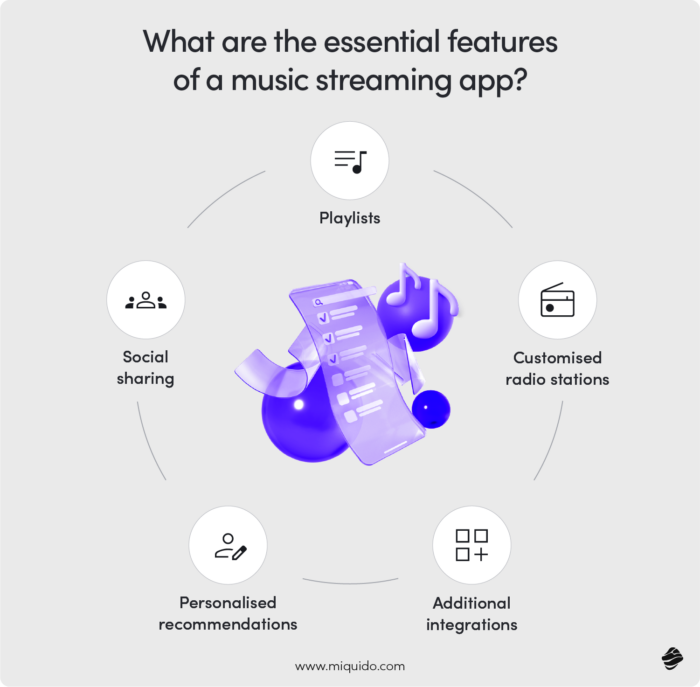
Conceptualisation phase
Working closely with your software development team is crucial to transform your ideas into a working music application. We start by creating a detailed project specification that acts as a guide to structure each step correctly.
This plan includes a comprehensive outline of the app’s functions, user types, how data and users will flow through the app, customer paths, technical needs, and other essential elements. It serves as a roadmap for the development team for the entire project.
At this point, we assess potential risks, look for ways to add unique value to the product, and identify opportunities to simplify the process. If the requirements are not yet fully defined, we hold a collaborative workshop where the client and development team can finalize the project goals. This workshop is flexible, designed to handle both broad ideas and detailed plans from the client.
During the conceptualization phase, we also discuss recommendations and non-functional requirements such as technology choices, workflows, tools, communication methods, project management practices, and testing approaches. We also talk about backend infrastructure options and setting up test environments to ensure smooth development and thorough testing. Having a solid concept and a skilled development team is essential for creating your own music app tailored to the current streaming landscape.
Technology stack selection
Choosing the right technology stack is crucial when developing music apps, and it involves close collaboration with your software development team. To ensure the app’s success, it’s vital to select tools that align with your goals and meet the project’s specific needs.
First, you’ll need to choose which platforms to develop for—iOS, Android, or both through a cross-platform solution, and consider if you want a web-based version of the app.
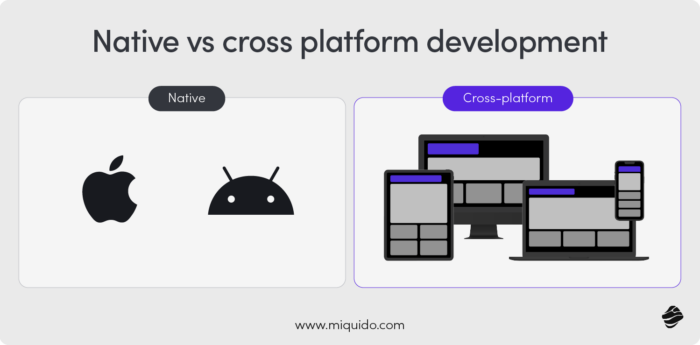
Native app development is the process of creating a mobile app exclusively for one native platform or device type, which is usually Android or iOS.
A native iOS app would never work on Android and vice versa. This is because different platforms require different development technologies and programming languages. For example, native app developers would use AppCode, Xcode or Atom to build an iOS app, but would need to use Android Studio to develop apps for Android.
iOS apps require programming languages such as Objective-C and Swift, whereas Android uses Java and Kotlin. Put simply, this means that if you want your app to be available on multiple platforms and mobile devices, you would need your developers to build different versions of it.
Cross-platform apps are those that are developed to operate on multiple platforms. With a cross-platform mobile app, the same code will run both for iOS and Android platforms, so your developer will only need to build one version for it to work across everything.
Javascript, C# and Dart are common programming languages used for cross-platform app development. There are also many popular cross-platform frameworks including React Native, Xamarin and Flutter.
Designing UI and UX
The music app design phase implies creating a seamless and visually captivating user experience (UX) and user interface (UI).
The process begins with creating wireframes and design mockups, which provide a skeletal structure outlining the app’s layout and functionalities. Designers’ main aim is to craft a user-friendly interface that aligns with the application’s purpose.
Often, the creative exploration begins with mood boards, allowing for the expression of preferences and inspirations – development teams refer to standardized design systems to deliver a consistent user interface in the most efficient way. However, throughout the design journey, the design system flow tends to be subject to occasional adjustments. The iterative nature of the process allows for interruptions like project re-estimation to verify plans against actual execution.
The UX design involves the meticulous crafting of user flows and mockups for each feature, with a keen focus on optimizing the user acquisition journey. The comprehensive approach incorporates usability testing, providing valuable insights that contribute to refining and enhancing the user experience. This iterative approach to design ultimately shapes the music app into a seamlessly navigable and aesthetically pleasing platform.
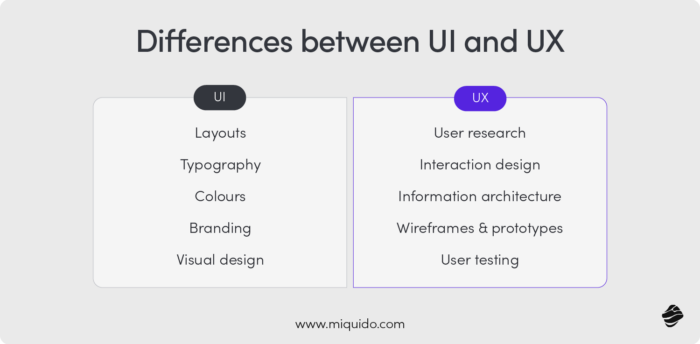
Development phase
Now, we can move on to the development phase, where we begin building the application according to the specified designs. Effective communication and feedback loops are vital during this stage, ensuring the development process and the client’s goals are aligned.
We’ll now turn to Piotr Polus, Engineering Lead at Miquido’s Music & Entertainment Business Unit. He’ll give you a closer look at how music and streaming apps are developed.
Customers often have significant influence and expectations of development, such as the inclusion of ready-made templates, preferred architectural frameworks, and specific components tailored to the desired technology. This approach allows for the seamless integration of creative ideas and technical precision, shaping a music streaming service that resonates with the client’s vision.
Crafting music and streaming apps is a complex process in which a number of activities occur simultaneously. It begins with a development kick-off when both parties meticulously analyze the project from a development standpoint. They schedule the work and prepare the API contract – an agreement for communication between the components of the system.
The backend development focuses on constructing server-side logic, databases, and APIs. Meanwhile, the front-end developers are working on an intuitive user interface. During this stage, ensuring a reliable internet connection is essential, as it directly impacts the streaming quality and overall user experience, especially for features like live streaming and real-time music recommendations.
Building a functional music streaming app: backend, frontend, core features and API integration
During the backend development, software engineers build the server-side logic, databases, and APIs essential for the music application’s smooth functioning. The backend is responsible for implementing robust user authentication and authorisation mechanisms and efficient data storage protocols. It is the foundation for the entire system and ensures the data flow is reliable.
Meanwhile, the frontend development team works on creating the user interface and client-side components. They aim to establish intuitive interactions with the backend, ensuring a seamless user experience. They also work on the app’s responsiveness to different screen sizes and devices, catering to the preferences of different users.
Moving forward, we get to the implementation of core features. Functionalities like playlists, search functionality, user profiles, and social features are carefully integrated into the application, improving its usability and social engagement. Additionally, developers work on more advanced features such as offline mode, recommendations, and personalized playlists, improving the app’s utility and personalisation to meet modern users’ expectations.
Integration of music services is another step on the way to delivering a comprehensive music app. This phase involves incorporating third-party music services into the app to give users access to a vast library of tracks. Developers use APIs from popular streaming services to provide users with access to a vast music library. This integration enhances the app’s functionality and broadens its appeal by tapping into existing music ecosystems.
Testing phase
One of the last phases of the application development process is rigorous testing to ensure the final product is solid and user-friendly. It employs comprehensive testing methodologies such as functional testing, performance testing, and user acceptance testing (UAT) to identify and fix any bugs or issues that may arise during the app’s lifecycle.
The testing process focuses on ensuring seamless functionality across diverse devices and platforms, emphasizing unit testing, integration testing, and user acceptance testing.
Finally, user acceptance testing is performed to address any minor bugs and ensure the flawless performance of the music app across various devices and operating systems. This phase is crucial for maintaining the app’s integrity, and customer involvement is encouraged to obtain valuable feedback.
Deployment phase
Once testing is complete, the music application is ready for deployment. It is the process of making the finalized application accessible and available to users on various platforms. This pivotal phase involves preparing the app for release on different operating systems, such as iOS and Android, and web interfaces.
Deployment transitions the app from the development and testing environments to a live production environment where end-users can download, install, and use the application. It encompasses tasks like packaging the app, configuring server settings, and ensuring compatibility with the target platforms.
Successful deployment ensures that music enthusiasts can seamlessly access the app’s features, explore its content, and enjoy a smooth user experience across various devices and platforms.
Post-launch support and maintenance
Collaboration with the software house doesn’t conclude with the app’s launch. Ongoing support and maintenance are essential to sustain a well-performing app. Working closely with the software house post-launch is necessary to address unforeseen issues and promptly implement updates or new features based on industry trends and valuable user feedback. This is particularly important for music streaming applications, which require continuous updates to meet user preferences and incorporate innovative features.
Analytics insights and vigilant monitoring of users’ behaviors enable further development of functionalities and areas that users mostly interact with. Consequently, data-based improvements result in better conversion rates.
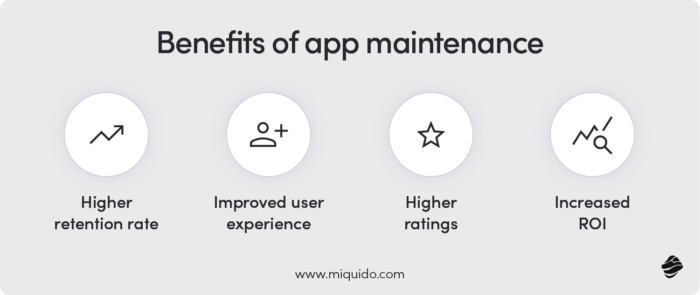
A service level agreement (SLA) usually seals maintenance assumptions. The document specifies aspects such as app verification models, standby mode, reaction time in the event of critical app errors, post-release support duration, the specific number of support personnel, and their availability.
Marketing and promotion strategies for music streaming apps
Marketing and promotion strategies are essential to the success of your music streaming app. You need to create a marketing strategy that will help you reach your target audience, increase brand awareness, and drive downloads.
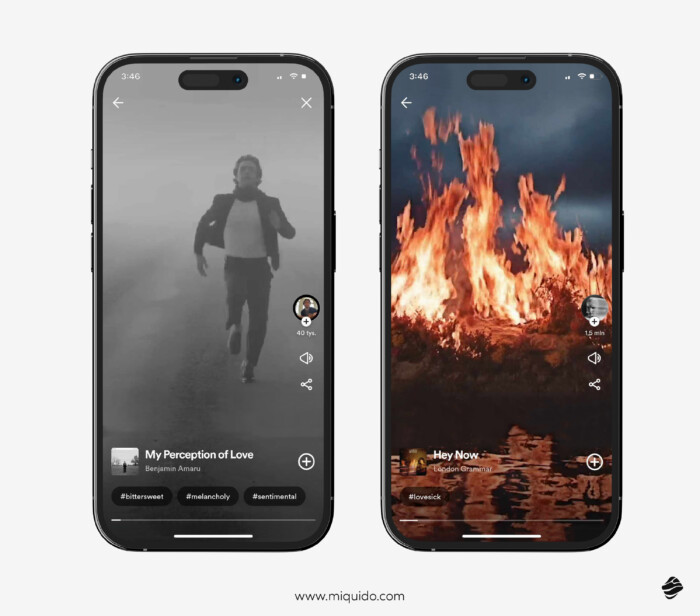
When creating your marketing strategy, consider the following factors:
- Target audience: Who is your target audience, and what are their music streaming habits? Understanding your audience will help you tailor your marketing efforts to reach them effectively.
- Brand awareness: How will you increase brand awareness, and what are your brand awareness strategies? Utilize social media integration, content marketing, and public relations to build your brand’s presence.
- Downloads: How will you drive downloads, and what are your download strategies? Consider using influencer marketing, paid advertising, and app store optimization to increase visibility and attract users.
Social media integration is essential for music streaming apps, as users expect to share songs and playlists on social media. By enabling easy sharing, you can increase your app’s visibility and attract new users. Influencer marketing can also be an effective way to promote your music streaming app, as influencers with large followings can introduce your app to a broader audience. Moreover, paid advertising, such as Google Ads and Facebook Ads, offers targeted advertising options to reach potential users and drive downloads.
Budgeting and cost management for music streaming app development
Budgeting and cost management are essential to the success of your music streaming app. You need to create a budget that will help you manage costs, ensure profitability, and drive growth.
When creating your budget, consider the following factors:
- Development costs: What are the development costs, including development time, resources, and technology? The cost of developing a music streaming app can range from $40,000 to $100,000 or more, depending on the complexity of the app and the technology used.
- Marketing costs: What are the marketing costs, including advertising, promotion, and brand awareness? Marketing costs can range from $10,000 to $50,000 or more, depending on the marketing strategy and the target audience.
- Revenue streams: What are your revenue streams, including subscription-based, advertising-based, and transactional-based models? Subscription-based models generate revenue through monthly subscriptions, while advertising-based models generate revenue through ads.
By carefully planning your budget and managing costs, you can ensure the financial success of your music streaming app. Consider multiple revenue streams to diversify your income and support your app’s growth. Regularly review and adjust your budget to account for changes in development and marketing needs, ensuring your app remains profitable and competitive in the music streaming market.
The summary: key insights for building music streaming apps
In conclusion, developing a successful music streaming app requires a structured approach, from concept creation to ongoing post-launch maintenance. Collaborating with a reputable music application development company can help ensure your app incorporates all the necessary elements, including music licensing, in-app purchases, and essential features like offline access and social media integration. By understanding your target audience and tailoring the app to meet their user preferences, you can enhance user engagement and create an app that resonates with music lovers.
In case you are more interested in technology, trends and tactics shaping the future of the music industry, we invite you to a free report:

As the global music streaming market expands, the potential for developing a standout music app grows as well. However, success requires innovation, regular updates, and a solid business model. Choosing the right technology stack, whether you opt for native or cross-platform app development, is essential for optimizing performance and user experience. With careful planning and the right development partner, your app can thrive in the competitive music streaming landscape and offer users a seamless, high-quality listening experience.


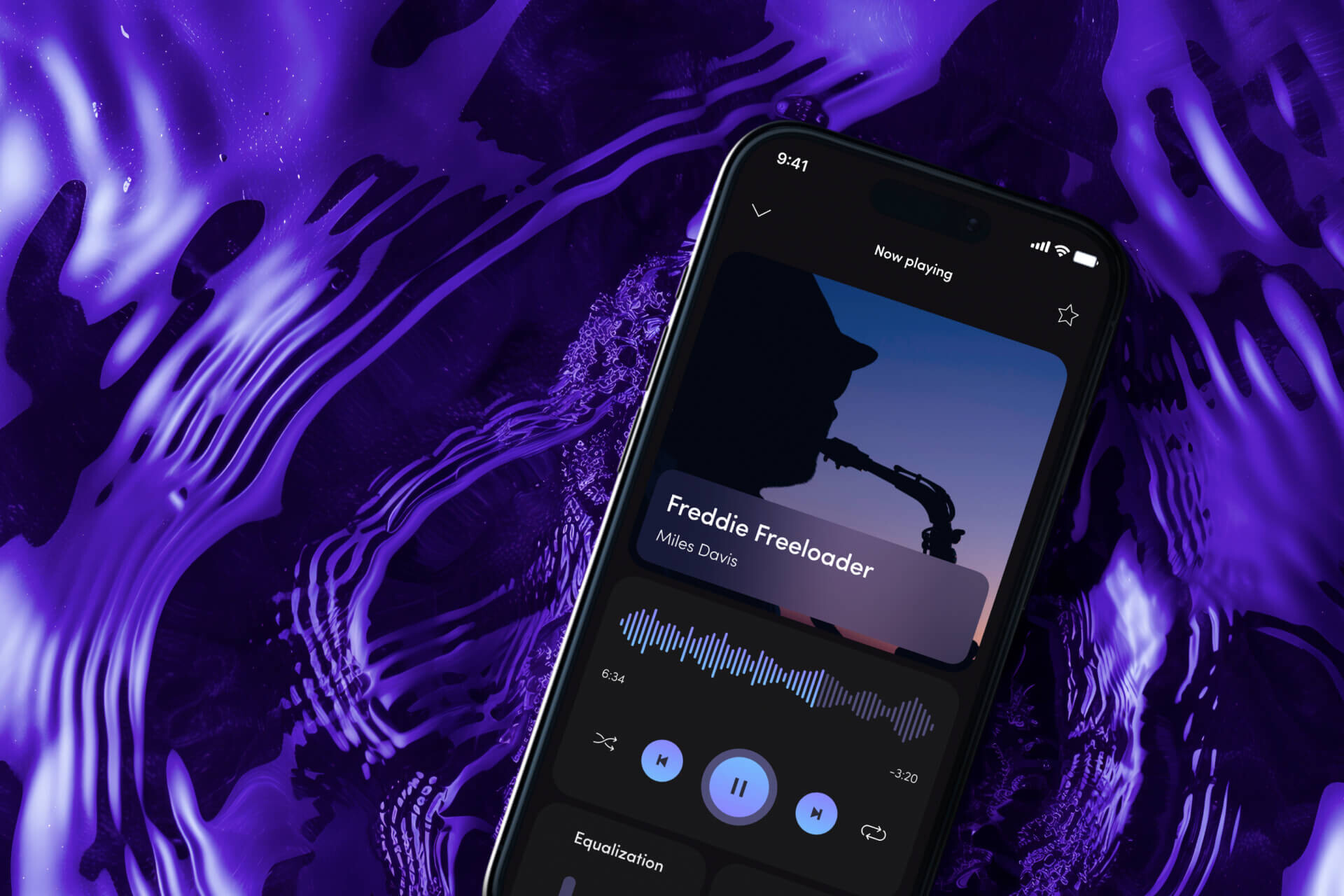
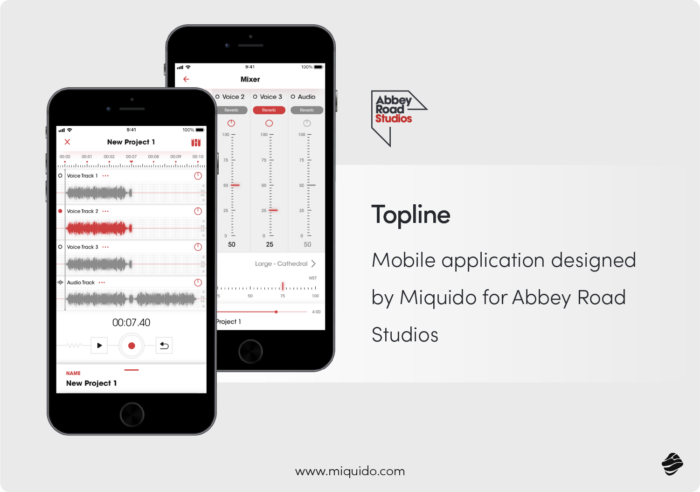



![[header] how is ai used in fintech use cases & insights](https://www.miquido.com/wp-content/uploads/2025/06/header-how-is-ai-used-in-fintech_-use-cases-insights-432x288.jpg)

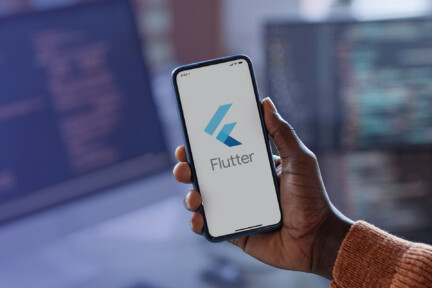

![[header] fintech choosing a cloud services provider](https://www.miquido.com/wp-content/uploads/2025/06/header-fintech-choosing-a-cloud-services-provider-432x288.jpg)
